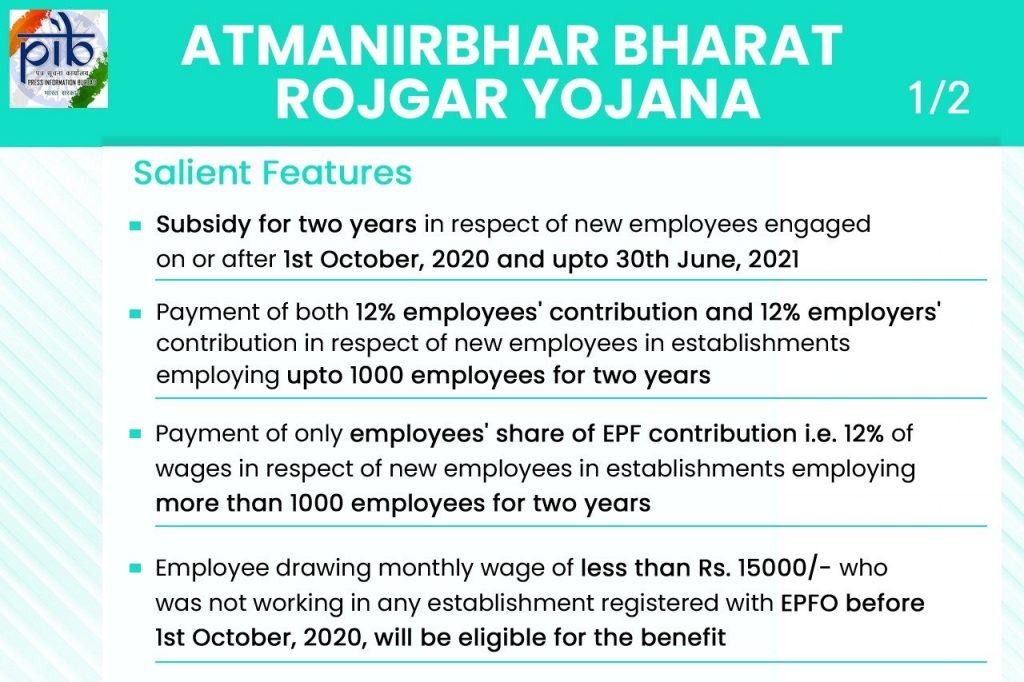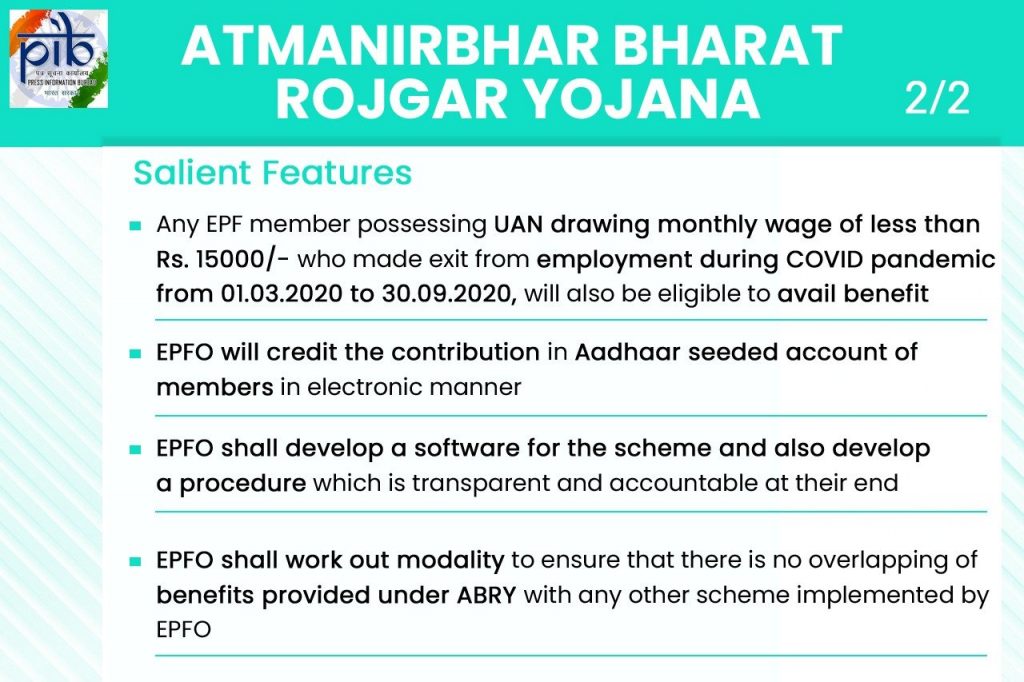Contents
- Atmanirbhar Bharat Rojgar Yojana (ABRY)
- Universal Service Obligation Fund Scheme
- Quantum Communication
ATMANIRBHAR BHARAT ROJGAR YOJANA (ABRY)
Focus: GS2 ;Welfare schemes for vulnerable sections of the population by the Centre and States and the performance of these schemes; mechanisms, laws, institutions and Bodies constituted for the protection and betterment of these vulnerable sections.
Why in News?
Cabinet approves Atmanirbhar Bharat Rojgar Yojana (ABRY)
About Atmanirbhar Bharat Rojgar Yojana (ABRY)
- The Union Cabinet has approved Atmanirbhar Bharat Rojgar Yojana at an expenditure of Rs. 1,584 crores for the current financial year and Rs.22,810 crores for the entire Scheme period i.e. 2020-2023 scheme to benefit around 58.5 lakh employees.
- The Union Cabinet, chaired by the Prime Minister, Narendra Modi, has given its approval for Atmanirbhar Bharat Rojgar Yojana (ABRY) to boost employment in formal sector and incentivize creation of new employment opportunities during the Covid recovery phase under Atmanirbhar Bharat Package 3.0.

- The Centre will provide subsidy for 2 years for new employees, this means for establishments with up to 1,000 employees, if they hire new employees at less than Rs 15,000 per month salary then centre will take care of the EPF contribution of both the employee (12%) & the employer (12%).
- For establishments with more than 1,000 employees, the Centre will support employee’s EPF contribution only (12%).
- With this scheme, the govt aims to incentivize the creation of new employment opportunities.

About Salient Features of Atmanirbhar Bharat Rojgar Yojana explained in above attached images.
UNIVERSAL SERVICE OBLIGATION FUND SCHEME
Focus: GS2 ;Welfare schemes for vulnerable sections of the population by the Centre and States and the performance of these schemes; mechanisms, laws, institutions and Bodies constituted for the protection and betterment of these vulnerable sections.
Why in News?
Cabinet approves Universal Service Obligation Fund Scheme for providing Mobile Coverage in Arunachal Pradesh and two Districts of Assam under the Comprehensive Telecom Development Plan for North Eastern Region
About Universal Service Obligation Fund Scheme (USOFS)
- It established in 2002, the USOFS is headed by the USOF Administrator who reports to the Secretary, Department of Telecommunications (DoT).
- The Indian Telegraph (Amendment) Act, 2003 gave statutory status to the Universal Service Obligation Fund (USOF)
- The USOF’s main aim is to provide universal telecom services and ensure that even the unconnected areas in the country reap the benefits of inclusive development.

Vision of USOFS
- By Enabling rural Indians to achieve their fullest potential and participate productively in the development of the nation by virtue of being effectively connected through a reliable and ubiquitous telecommunications network, access to which is within their reach and within their means.
Objective of USOFS
- Economic: Network extension & stimulate uptake of the ICT services.
- Social: Mainstreaming the underserved & un-served areas/groups by bridging the Access Gap.
- Political: to enable citizens exercise their political rights in an informed way and
- Constitutional: Equitable distribution of the fruits of the telecom/digital revolution and fair allocation of national resource (pooled USO levy) via targeted subsidies
About Functions of the USOFS
- To provide widespread and non-discriminatory access to quality Information and communications technology (ICT) services at affordable prices to people in rural and remote areas.
- To provide an effective and powerful linkage to the hinterland thereby mainstreaming the population of rural and remote parts of the country.
- To ensure that universal services are provided in an economically efficient manner.
- To ensure that by developing hitherto unconnected areas, the benefits of inclusive growth are reaped by our nation, bringing in its wake rapid socio-economic development and improved standards of living.
About Fund of USOFS
- The funds come from Universal Service Levy (USL), the New Telecom Policy – 1999 (NTP99) provided that the resources for meeting the Universal Service Obligation (USO) would be raised through a ‘Universal Access Levy (UAL), which would be a percentage of the revenue earned by the operators under various licenses.
- The USL is charged from all the telecom operators on their Adjusted Gross Revenue (AGR).
- These are then deposited into the Consolidated Fund of India, and prior parliamentary approval is required for dispatching.
Extra Info
About Adjusted Gross Revenue (AGR)
- The Adjusted Gross Revenue (AGR) is the usage and licensing fee that telecom operators are charged by the Department of Telecommunications (DoT).
- It is divided into spectrum usage charges and licensing fees, pegged between 3-5 percent and 8 percent respectively.

- As per DoT, the charges are calculated based on all revenues earned by a telco – including non-telecom related sources such as deposit interests and asset sales.
QUANTUIM COMMUNICATION
Focus: GS 3 ;Science and Technology- developments and their applications and effects in everyday life.
Why in News?
Quantum Communication between two DRDO Laboratories
About Quantum Communications
- The Quantum communication is a field of applied quantum physics closely related to quantum information processing and quantum teleportation.
- Its most interesting application is protecting information channels against eavesdropping by means of quantum cryptography.

Above image shows the Quantum Communication through secure channel.
- The Quantum communication boasts ultra-high security communication.
- It uses subatomic particles to securely communicate between two points.
- These subatomic particles are mainly quantum entanglement of photons.
- It ensures that nobody taps into the line as a photon can be neither separated nor duplicated.
- In case intruder (hacker) tries to crack the message in Quantum communication, it will change its form in a way that would alert the sender and cause the message to be altered or deleted.
- Thus tapping the network will inevitably corrupt the signal.
- It has the ability to inform the two communicating users of the presence of any third party trying to eavesdrop.
- At the same time, the information being intercepted will self-destruct.
- It holds enormous prospects in the field of Defense.
- The China had successfully launched the world’s first quantum satellite in August, 2016, dubbed as Quantum Experiments at Space Scaler (QUESS) satellite.
- It was nicknamed as Micius after a 5th century BC Chinese philosopher and scientist.

Applications of Quantum Communication
- It will enable the space-to-Earth highly secure hack-proof quantum communication network.
- The satellite will help to establish hack-proof communications system by transmitting uncrackable keys from space to the ground.
- The Ranges from highly secured military and government communications to online shopping.
- This will enable the space-to-Earth quantum communication network.
- This is first of its kind satellite-based quantum network would make it possible to send quickly encrypted (hack proof) messages around the world.
- It also opens door to other possible uses of the technology.

Above image of Union Budget 2020-21 proposed to spend ₹8,000 crore ($ 1.2 billion) on the newly launched National Mission on Quantum Technologies and Applications (NMQTA).
Conclusion
- It could take quite a few years for quantum computers to achieve their full potential. Universities and businesses working on them are facing a shortage of skilled researchers in the field and a lack of suppliers of some key components. But if these exotic new computing machines live up to their promise, they could transform entire industries and turbocharge global innovation.





